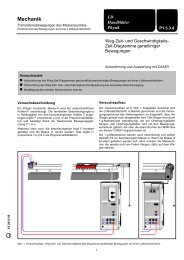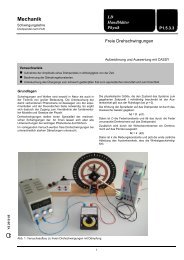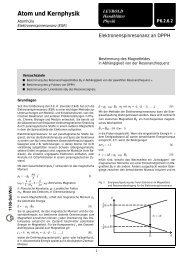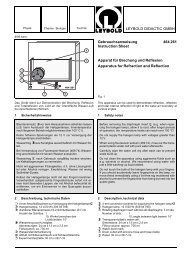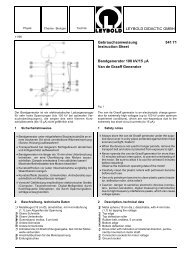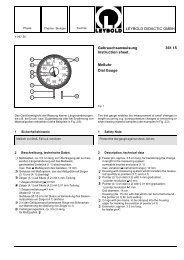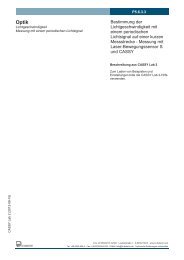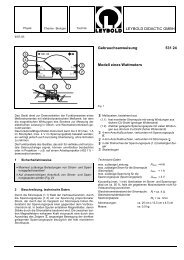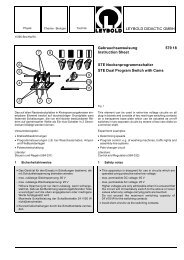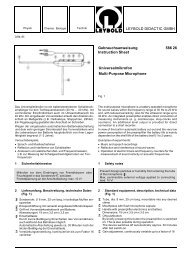LEYBOLD DIDACTIC GMBH Gebrauchsanweisung 332 101 ...
LEYBOLD DIDACTIC GMBH Gebrauchsanweisung 332 101 ...
LEYBOLD DIDACTIC GMBH Gebrauchsanweisung 332 101 ...
Sie wollen auch ein ePaper? Erhöhen Sie die Reichweite Ihrer Titel.
YUMPU macht aus Druck-PDFs automatisch weboptimierte ePaper, die Google liebt.
Physik Chemie ⋅ Biologie Technik <strong>LEYBOLD</strong> <strong>DIDACTIC</strong> <strong>GMBH</strong><br />
6/95-Pr/Sf-<br />
<strong>Gebrauchsanweisung</strong> <strong>332</strong> <strong>101</strong><br />
Instruction Sheet<br />
Gravitations-Drehwaage<br />
Gravitation Torsion balance<br />
Fig. 1<br />
Gravitations-Drehwaage (<strong>332</strong> <strong>101</strong>) sowie schematische Darstellung<br />
zum Meßprinzip<br />
Gravitation torsion balance (<strong>332</strong> <strong>101</strong>) and schematic diagram<br />
of measuring principle<br />
Das Gerät dient zur Demonstration der durch Gravitationskräfte<br />
verursachten Massenanziehung und zur Bestimmung der Gravitationskonstanten<br />
f.<br />
Meßprinzip (Fig.1)<br />
Ein Torsionspendel mit einer Schwingungsdauer von etwa<br />
10 min wird durch eine Positionsänderung der äußeren Massen<br />
m 1, die auf den hantelförmigen Pendelkörper wirken, in seinem<br />
statischen Gleichgewicht (Stellung I) gestört; es führt gedämpfte<br />
Schwingungen aus und schwingt in eine neue Gleichgewichtslage<br />
(Stellung II) ein. Der Winkel zwischen beiden Gleichgewichtslagen<br />
ist ein Maß für die wirksame Gravitationskraft.<br />
Die Schwingung des Pendels, an dem ein Hohlspiegel angebracht<br />
ist, wird durch eine Lichtmarke angezeigt, wahlweise<br />
- mit sichtbarem Licht direkt auf einer mm-Skala oder<br />
- mit Infrarot-Licht unter Verwendung des IR-Position-Detectors<br />
(<strong>332</strong> 11), der eine Schreiberaufzeichnung oder eine<br />
computerunterstützte Meßwerterfassung ermöglicht.<br />
Aus dem zeitlichen Verlauf der Schwingung, der Masse m 1 und<br />
der Geometrie der Anordnung ermittelt man die Gravitationskonstante<br />
f entweder nach der Endausschlagmethode oder (bei verkürztem<br />
Meßverfahren) nach der Beschleunigungsmethode.<br />
Bei der Endausschlagmethode werden die Schwingungsdauer<br />
T des Torsionspendels und der Abstand S zwischen den<br />
Lichtzeigerpositionen für die beiden Gleichgewichtslagen ausgewertet:<br />
f = π 2 ⋅ b 2 ⋅ d ⋅ S<br />
m 1 ⋅ T 2 ⋅ L<br />
Bei der Beschleunigungsmethode wird die Beschleunigung<br />
a = 2s/t 2 des Torsionspendels nach der Störung seiner Gleichgewichtslage<br />
durch die Massen m 1 ausgewertet:<br />
S ⋅ d ⋅ b 2<br />
f =<br />
2 m 1 ⋅ t 2 (II)<br />
⋅ L<br />
(I)<br />
The device can be used to demonstrate the gravitational<br />
attractive force between masses and to determine the gravitational<br />
constant f.<br />
Measurement principle (Fig.1)<br />
The static equilibrium (position I) of a torsion pendulum with a<br />
period of approx. 10 min. is disturbed by a change in position<br />
of the outer masses m 1, which affect the dumbbell-shaped<br />
pendulum body. The oscillations become damped and the<br />
pendulum takes up a new equilibrium position (position 2). The<br />
angle between the two positions is a measure of the active<br />
gravitational force.<br />
The oscillation of the pendulum, which is equipped with a concave<br />
mirror, is indicated by a light pointer. This is possible using<br />
- visible light directly on a mm-scale or<br />
- infrared light along with the IR position detector (<strong>332</strong> 11). The<br />
latter enables the measurement values to be plotted or<br />
evaluated by computer.<br />
The gravitational constant f can be obtained from the oscillation<br />
curve with respect to time, the mass m 1 and the geometry of the<br />
arrangement using either the end deflection method or (in a<br />
quicker process) the acceleration method.<br />
In the end deflection method the torsion pendulum period T and<br />
the distance S separating the light pointer positions are evaluated<br />
for the two equilibrium positions:<br />
f = π 2 ⋅ b 2 ⋅ d ⋅ S<br />
m 1 ⋅ T 2 ⋅ L<br />
In the acceleration method, the acceleration of the torsion<br />
pendulum a = 2s/t 2 is evaluated using the masses m 1 after the<br />
equilibrium position has been disturbed:<br />
S ⋅ d ⋅ b 2<br />
f =<br />
2 m 1 ⋅ t 2 (II)<br />
⋅ L<br />
(I)
1 Sicherheitshinweise<br />
Das empfindliche Bronzeband des Torsionspendels vor unkontrollierter<br />
mechanischer Belastung schützen:<br />
- Arretierschrauben 7 für das Schwingungssystem - siehe<br />
Fig. 2 - erst lösen, wenn das Gerät ordnungsgemäß montiert<br />
und in Versuchsposition gebracht ist.<br />
- Schwingungssystem stets arretieren, wenn das Gerät<br />
nicht benutzt wird; Arretierung insbesondere beim Transport<br />
und bei der Montage sicherstellen.<br />
Rändelschraube (3.1) - siehe Fig. 2 - zur Fixierung des bei<br />
Lieferung vorjustierten Torsionskopf nur dann geringfügig<br />
lockern, wenn nach ordnungsgemäßer Montage der<br />
Drehwaage bei deren Inbetriebnahme eine Feinjustierung<br />
des Nullpunktes erforderlich sein sollte.<br />
Madenschraube (3.2) - siehe Fig. 2 - zur Fixierung des Pendelhalters<br />
nur lösen beim Austausch des Torsionsbandes<br />
gemäß Abschnitt 4.<br />
1 Safety notes<br />
Protect the sensitive bronze band of the torsion pendulum<br />
from uncontrolled mechanical loading:<br />
- Do not unscrew the oscillating system’s locking screws 7<br />
- see Fig. 2 - before the device has been correctly<br />
assembled and brought into position.<br />
- Always lock the oscillating system when the device is not<br />
in use. In particular, make sure it is locked during transport<br />
and assembly.<br />
The knurled screw (3.1) - see Fig. 2 - for fixing the torsion<br />
head (preadjusted on delivery) is only to be slightly<br />
loosened if a fine adjustment of the zero point proves<br />
necessary on putting the correctly-assembled torsion balance<br />
into operation. The grub screw (3.2) - see Fig. 2 - for fixing<br />
the pendulum holder is only to be loosened when replacing<br />
the torsion band as described in section 4.<br />
2 Beschreibung, technische Daten, Lieferumfang<br />
(siehe Fig. 2)<br />
2 Description, technical data, scope of supply<br />
(see Fig. 2)<br />
Fig.2<br />
Gravitations-Drehwaage.<br />
Gravitation torsion balance<br />
1 Metallgehäuse ( ∅15 cm), mit Metallring und Glasabdeckungen;<br />
zweiteilige Blende (1.1) zur Verminderung störender Konvektionen<br />
zwischen Gehäuse und Schutzrohr 2<br />
2 Schutzrohr (25 cm lang) für Torsionsband 4<br />
3 Torsionskopf mit Pendelhalter, bei gelockerter Schraube (3.1)<br />
drehbar zur Justierung der Gleichgewichtslage des Pendels;<br />
Pendelhalter mit Madenschraube (3.2) fixiert<br />
Wichtig!<br />
Rändelschraube (3.1) nur lösen, wenn eine Nullpunktjustierung<br />
gemäß Abschnitt 3.5 erforderlich ist.<br />
Madenschraube (3.2) nur lösen beim Austausch des<br />
Torsionsbandes gemäß Abschnitt 4.<br />
4 Torsionsband aus Bronze, 26 cm lang<br />
Ersatzteil-Nr: 683 21<br />
5 hantelförmiger Pendelkörper, bestehend aus 2 Bleikugeln (5.1)<br />
auf Metallstab<br />
6 Hohlspiegel für Lichtmarken-Anzeige der Pendelbewegung<br />
1 Metal housing (15 cm dia.), with metal ring and glass covers;<br />
two-part slide (1.1) to prevent interference from convection<br />
currents between the housing and protective tube (2)<br />
2 Protective tube (25 cm long) for torsion band 4<br />
3 Torsion head with pendulum holder,<br />
can be rotated for adjustment of the pendulum equilibrium<br />
position when screw has been loosened (3.1);<br />
pendulum holder fixed with grub screw (3.2)<br />
Important!<br />
Do not loosen the knurled screw (3.1) unless it is essential<br />
to carry out a zero-point adjustment in accordance with<br />
section 3.5. Only loosen the grub screw (3.2) when the<br />
torsion band is being replaced as described in section 4.<br />
4 Torsion band made from bronze, 26 cm long<br />
Spare part no.: 683 21<br />
5 Dumbbell-shaped pendulum body, consisting of 2 lead balls<br />
(5.1) on a metal rod<br />
2
Brennweite f ca. 30 cm<br />
7 Schrauben zur Arretierung des Pendelkörpers 5 durch Federpaar<br />
(7.1)<br />
8 Paar große Bleikugeln<br />
Ersatzteil-Nr. für 1 Kugel: 683 22<br />
9 Kugelträger, um Stativstange B schwenkbar, zur versuchsgerechten<br />
Anordnung der großen Bleikugeln 8<br />
A Auflagering mit Fixierschraube (10.1) für Kugelträger<br />
B Stativstange (9 cm x 1,2 cm ∅) zu Aufbau des Gerätes in<br />
Stativmaterial<br />
Im Lieferumfang enthalten:<br />
1 m selbstklebendes Skalenband mit cm- und mm-Teilung<br />
Versuchswichtige Daten (siehe Fig. 1):<br />
Gehäusetiefe: 30 mm<br />
Torsionspendel<br />
Schwingungsdauer: etwa 10 min<br />
Durchmesser / Masse m 2 einer Bleikugel (5.1):<br />
15 mm / 20 g<br />
Abstand d eines Kugelmittelpunktes zur Drehachse: 50 mm<br />
Durchmesser / Masse m 1 einer großen Bleikugel 8:<br />
64 mm / 1.5 kg ±5 g<br />
Abstand b zwischen den Mittelpunkten der goßen Kugel (bei<br />
Gehäuseberührung) und der kleinen Kugel (in Nullage): 47 mm<br />
3 Bedienung<br />
Wichtig !<br />
Zufriedenstellende Versuchsergebnisse werden nur dann<br />
erzielt, wenn das Torsionspendel einwandfrei justiert ist<br />
und wenn die durch die Massenanziehung bewirkten Torsionsschwingungen<br />
durch keine unerwünschten Pendelbewegungen<br />
beeinträchtigt werden.<br />
Das Pendel reagiert sehr empfindlich auf Erschütterungen,<br />
die auf die Versuchsanordnung übertragen werden.<br />
Ein stabiler Aufbau an einer festen Wand oder auf einem<br />
schweren Tisch ist daher unerläßlich.<br />
Temperaturschwankungen bewirken im Gehäuse der<br />
Drehwaage Konvektionen, die zu unerwünschten Bewegungen<br />
(s. Fig. 6) des Torsionspendels führen.<br />
Deshalb ist der Experimentierplatz so zu wählen, daß die<br />
Drehwaage keiner Sonneneinstrahlung und keinen Luftbewegungen<br />
ausgesetzt ist.<br />
3.1 Zusätzlich erforderliche Geräte<br />
3.1.1. Schwingungsanzeige durch (sichtbare) Lichtmarke<br />
auf einer mm-Skala<br />
1 Lampengehäuse 450 60<br />
1 Lampe, 6 V, 30 W 450 51<br />
1 asphärischer Kondensor (mit 1-mm-Spaltblende) 460 20<br />
1 Wechselspannungsquelle, 6 V, 30 W z.B 562 73<br />
1 Rollbandmaß 311 77<br />
1 Stoppuhr z.B. 313 05<br />
1 Schwebemagnet 510 44<br />
Wand-Aufbau (siehe Fig. 3)<br />
1 Großer Stativfuß 300 01<br />
1 Paar Stellschrauben 301 06<br />
1 Leybold-Muffe 301 01<br />
1 Drehmuffe 301 03<br />
1 Stativstange, 47 cm 300 42<br />
Montagehilfen und -zubehör:<br />
Bohrmaschine, Steinbohrer, Dübel (6 mm)<br />
Tisch-Aufbau<br />
1 Optische Bank mit Normalprofil, 1 m 460 32<br />
2 Optikreiter z. B. 460 351<br />
6 Concave mirror for light pointer indication of pendulum motion<br />
Focal length f approx.30 cm<br />
7 Screws for locking the pendulum body 5 using pair of<br />
springs (7.1)<br />
8 Pair of large lead balls<br />
Spare part no. for 1 ball: 683 22<br />
9 Ball carrier, can be rotated around stand rod B, for correct<br />
experimental arrangement of the large lead balls 8<br />
A Supporting ring with fixing screw (10.1) for ball carrier<br />
B Stand rod (9 cm x 1.2 cm dia.) for assembly of the device in<br />
stand material<br />
Included in scope of supply:<br />
1 m self-adhesive scale tape with cm and mm divisions<br />
Important experimental data (see Fig. 1):<br />
Housing depth: 30 mm<br />
Torsion pendulum<br />
Period: approx. 10 min<br />
Diameter / mass m 2 of a lead ball (5.1):<br />
15 mm / 20 g<br />
Distance d between the center of a ball and the axis of<br />
rotation: 50 mm<br />
Diameter / mass m 1 of a large lead ball 8:<br />
64 mm / 1.5 kg ±5 g<br />
Distance b between the center of the large ball (when contact is made<br />
with housing) and the small ball (in the equilibrium position): 47 mm<br />
3 Operation<br />
Important !<br />
Satisfactory experiment results are only possible when<br />
the torsion pendulum has been properly adjusted and<br />
the torsion oscillations produced by attraction between<br />
the masses are not affected by unwanted pendulum movements.<br />
The pendulum is very sensitive to any disturbance<br />
of the experiment setup: make sure that the experiment setup<br />
is absolutely stable, e.g. by attaching it to a solid wall<br />
or placing it on a sturdy bench or table.<br />
Temperature variations cause convection in the housing<br />
of the torsion balance, which in turn cause undesired motions<br />
of the torsion pendulum (see Fig. 6).<br />
For this reason, select an experiment site which does not<br />
stand in direct sunlight or drafts.<br />
3.1 Additional equipment required<br />
3.1.1. Oscillation indication using (visible) light marks on a<br />
mm-scale<br />
1 Lamp housing 450 60<br />
1 Lamp, 6 V, 30 W 450 51<br />
1 Aspherical condenser (with 1-mm slit screen) 460 20<br />
1 A.C. voltage source, 6 V, 30 W e.g. 562 73<br />
1 Steel tape measure 311 77<br />
1 Stop-clock e.g. 313 05<br />
1 Suspended magnet 510 44<br />
Wall assembly (see Fig. 3)<br />
1 Large stand base 300 31<br />
1 Pair of levelling screws 300 06<br />
1 Leybold multiclamp 301 01<br />
1 Rotatable clamp 301 03<br />
1 Stand rod, 47 cm 300 42<br />
Assembly aids and accessories:<br />
Electric drill, masonry drill bit, wall plugs (6 mm)<br />
Benchtop assembly<br />
1 Optical bench with normal profile, 1 m 460 32<br />
2 Optical riders e.g. 460 351<br />
3
Fig. 3<br />
Aufbau der Gravitations-Drehwaage; Anzeige des Schwingungsverlaufs<br />
durch (sichtbaren) Lichtzeiger auf einer mm-<br />
Skala (für IR-Positions-Detector, <strong>332</strong> 11, ungeeignet!)<br />
Setup for the gravitation torsion balance; display of the oscillation<br />
curve by means of (visible) light pointer on mm-scale (not<br />
suitable for IR position detector <strong>332</strong> 11!)<br />
Fig. 4<br />
Aufbau der Gravitations-Drehwaage; elektronische Erfassung<br />
des Schwingungsverlaufs durch IR-Position-Detector (<strong>332</strong> 11);<br />
Aufzeichnung mit TY-Schreiber oder Weiterverarbeitung mit<br />
Computerunterstützung (s. Fig. 4.1)<br />
Benchtop assembly of the gravitation torsion balance; electronic<br />
determination of the oscillation curve using an IR position<br />
detector (<strong>332</strong> 11); recording with TY-recorder or further processing<br />
with computer assistance (see Fig. 4.1)<br />
3.1.2 Schreiberaufzeichnung oder computerunterstützte<br />
Erfassung der Schwingung mit Infrarot-Licht; Schienenaufbau<br />
auf einem Tisch (siehe Fig. 4)<br />
1 Infrarot-Position-Detector <strong>332</strong> 11<br />
1 Wechselspannungsquelle, 12 V z.B. 562 73<br />
1 TY-Schreiber z. B. 575 701<br />
oder<br />
MS-DOS-Rechner über serielle Schnittstelle<br />
RS 232-Kabel z.B. 530 008<br />
Programm mit versuchsspezifischen Voreinstellungen z.B.<br />
auf der Demo-Diskette zur "Universellen Meßwerterfassung",<br />
enthalten in Lieferumfang des IR-Position-Detector<br />
(<strong>332</strong> 11); Meßbeispiel s. Fig. 4.1<br />
oder<br />
MS-DOS-Rechner mit Interface<br />
CASSYpack-E 524 007<br />
Programm "Messen und Auswerten" 524 111<br />
1 Rollbandmaß 311 77<br />
1 Schwebemagnet 510 44<br />
1 Optische Bank mit Normalprofil, 1 m 460 32<br />
2 Optikreiter z. B. 460 351<br />
1 Stativstange, 25 cm z. B. 300 41<br />
Hinweis:<br />
Weitere Informationen zum Einsatz des Infrarot-Position-<br />
Detector finden Sie in der zugehörigen <strong>Gebrauchsanweisung</strong>.<br />
3.1.2 Recorder plotting or computer-assisted recording of<br />
the oscillation using infrared light; rail assembly on a<br />
bench (see Fig. 4)<br />
1 Infrared position detector <strong>332</strong> 11<br />
1 A.C. voltage source, 12 V e.g. 562 73<br />
1 TY-recorder e.g. 575 701<br />
or<br />
MS DOS computer via serial interface<br />
RS 232 cable e.g. 530 008<br />
Program with experiment-specific default settings e.g.<br />
contained on the demo disk for "Universal Data Acquisition",<br />
included in the scope of supply of the IR position detector<br />
(<strong>332</strong> 11); see measuring example Fig. 4.1.<br />
or<br />
MS DOS computer with interface<br />
CASSYpack-E 524 007<br />
Program "Measuring and Evaluating" 524 112<br />
1 Steel tape measure 311 77<br />
1 Suspended magnet 510 44<br />
1 Optical bench with normal profile, 1 m 460 32<br />
2 Optical riders e.g. 460 351<br />
1 Stand rod, 25 cm e.g. 300 41<br />
Note:<br />
Further information on the use of the infrared position<br />
detector can be found in the corresponding Instruction<br />
Sheet.<br />
Fig. 4.1<br />
Computerunterstützte Aufzeichnung der Schwingungen der<br />
Gravitationsdrehwaage<br />
Computer-assisted recording of the oscillations of the gravitation<br />
torsion balance<br />
4
3.2 Wandmontage des Stativfußes (vor Erstinbetriebnahme<br />
erforderlich für einen Aufbau an der Wand gemäß<br />
Fig. 3)<br />
Wichtig:<br />
Diese Wandmontage des Stativmaterials ist ungeeignet für den<br />
Aufbau mit IR-Position-Detector (s. Abschnitt 3.1.2; Fig. 4)<br />
Stativfuß an seiner Scheitelbohrung gemäß Fig. 5.1 - 5.3 fachgerecht<br />
eindübeln und mit Hilfe der Stellschrauben parallel zur<br />
Wand ausrichten; falls sich die Stellschrauben in die Wand eindrücken,<br />
feste Unterlage benutzen.<br />
3.2 Mounting the stand base on the wall (required for<br />
wall mounting as shown in Fig. 3 before using the<br />
setup for the first time.)<br />
Important:<br />
Wall mounting of the stand material is not suitable for the experiement<br />
setup with the IR position detector <strong>332</strong> 11 (see section<br />
3.1.2; Fig. 4).<br />
Correctly mount the stand base on its apex hole as shown in Fig.<br />
5.1 - 3.3 and align parallel to the wall using levelling screws; use<br />
solid base material if the levelling screws press into the wall.<br />
Fig. 5.1-5.3<br />
Wandmontage des Stativfußes<br />
Wall-mounting of the stand base<br />
3.3 Versuchsvorbereitung<br />
Anordnung - zunächst ohne die großen Bleikugeln - gemäß<br />
Fig. 3 an der Wand (oder sinngemäß auf einem stabilen Tisch<br />
auf der Optischen Bank) aufbauen .<br />
Lampengehäuse so ausrichten, daß der reflektierte Strahl ungehindert<br />
auf die mindestens 5 m entfernte Skala projiziert wird.<br />
Leuchtwendel lotrecht ausrichten, bevor der Kondensor mit<br />
Blendenhalter und Spalt (lotrecht!) auf das Lampengehäuse<br />
aufgesteckt wird.<br />
Durch Verschieben des Einsatzes im Lampengehäuse Wendel<br />
scharf auf den Spiegel der Drehwaage abbilden. Dazu ein<br />
weißes Blatt Papier direkt vor die Waage halten, auf welchem<br />
die Leuchtwendel sichtbar wird.<br />
Lampengehäuse so verschieben, daß der Spalt scharf auf der<br />
Skala abgebildet wird.<br />
Erforderlichenfalls den Nullpunkt gemäß Abschnitt 3.5 justieren.<br />
Bleikugeln auflegen und in eine Extremstellung bringen. Dabei<br />
Berühren des Gehäuses durch Finger oder Bleikugeln unbedingt<br />
vermeiden.<br />
3.4 Versuchsdurchführung; Meßbeispiel<br />
Wichtig!<br />
Anordnung nach dem Aufbau gemäß Abschnitt 3.3 mindestens<br />
zwei Stunden erschütterungsfrei stehen lassen, sodaß<br />
das Pendel in die Gleichgewichtslage einschwingen kann.<br />
Kugelträger 9 ohne Gehäuseberührung umschwenken.<br />
Zur Verkürzung der Beruhigungszeit für das Pendel den<br />
Diamagnetismus des Bleis ausnutzen: Wenn sich eine der<br />
Bleikugeln des Pendelkörpers der Glasabdeckung nähert,<br />
einen starken Magneten bis zur Umkehr des Systems dagegenhalten,<br />
ohne das Glas zu berühren.<br />
Versuchsanordung während der Meßwerterfassung keiner<br />
mechanischen Erschütterung und keinen Temperaturschwankungen,<br />
die zu Konvektionen in Gehäuse der<br />
Drehwaage führen können, aussetzen (s. Fig. 6)<br />
Vor Beginn der Messungen Stabilität des Nullpunktes kontrollieren.<br />
Nullpunktschwankungen erforderlichenfalls über mindestens<br />
10 Minuten beobachten und dokumentieren; daraus x 0<br />
mitteln.<br />
Zum Zeitpunkt t = 0 den Träger mit den Bleikugeln zügig, aber<br />
so vorsichtig von der einen in die andere Extremstellung<br />
schwenken, daß das Gehäuse weder von den Fingern, noch<br />
von den Bleikugeln berührt wird. Unmittelbar nach dem Umschwenken<br />
Stoppuhr starten.<br />
Für die Endausschlagmethode über mindestens 3 Schwingungsperioden,<br />
für die Beschleunigungsmethode über 1 Peri-<br />
3.3 Preparing for the experiment<br />
Assemble the arrangement - initially without the large lead balls<br />
- on the wall as shown in Fig. 3 (or similarly on the optical bench<br />
on a sturdy lab bench).<br />
Align the lamp housing so that the reflected beam is projected<br />
unobstructed onto the scale, which should be positioned at<br />
least 5 m distant.<br />
Align the filament so that it is vertical before attaching the<br />
condenser with screen holder and slit (vertically!) to the lamp<br />
housing.<br />
Move the insert in the lamp housing so that a focused image of<br />
the filament is projected onto the torsion balance mirror. To do<br />
this, hold a white sheet of paper, on which the filament forms an<br />
image, directly in front of the balance.<br />
Move the lamp housing so that the slit is focused onto the scale.<br />
If necessary, adjust the zero-point as described in section 3.5.<br />
Attach the lead balls and bring the arrangement to an extreme position.<br />
In carrying out this step make absolutely sure that the housing<br />
does not come into contact with either your finger or a lead ball.<br />
3.4 Experiment procedure; measuring example<br />
Important!<br />
After the experiment has been set up as described in section<br />
3.3, it must be left undisturbed for at least two hours so that<br />
the pendulum can settle in its equilibrium state.<br />
Turn the ball carrier 9 without touching the housing.<br />
To shorten this settling time, make use of the diamagnetism<br />
of the lead: each time one of the pendulum<br />
lead balls approaches the glass cover, hold up a strong<br />
magnet - without touching the glass - until the motion of<br />
the system is reversed.<br />
The experiment setup must not be subjected to any shocks<br />
or temperature variations which may cause convention in<br />
the torsion balance housing while recording measured<br />
values (see Fig. 6)<br />
Check the zero-point stability before starting the measurement. If<br />
necessary, observe and note the zero-point fluctuations for at least<br />
10 minutes so that you can determine an average value for x 0.<br />
At time t = 0 rotate the carrier with the lead balls quickly from<br />
one extreme position to the other. However, in carrying out this<br />
movement, make sure that fingers or lead balls do not come<br />
into contact with the housing. Start the stop-clock immediately<br />
after shifting the carrier.<br />
Read off and note the position of the light pointer on the scale<br />
every 30 s (Fig. 6) for at least 3 periods when using the end<br />
displacement method and for 1 period when using the acceleration<br />
5
Fig. 6<br />
24-Stunden-Protokoll über die Position des Torsionspendels:<br />
Positionsänderung im wesentlichen bedingt durch tageszeitabhängige<br />
Temperaturschwankungen (besonders ausgeprägt<br />
bei direkter Sonneneinstrahlung)<br />
24-hour log of the position of the torsion pendulum: position<br />
changes are essentially due to (day)time dependent variations<br />
in temperature (particularly noticeable for exposure to direct<br />
sunlight)<br />
Fig. 7<br />
Schwingungen der Gravitationsdrehwaage um die Endgleichgewichtslage<br />
x 00<br />
Oscillations of the gravitation torsion balance around the final<br />
equilibrium position x 00<br />
ode die Stellung des Lichtzeigers auf der Skala alle 30 s ablesen<br />
und notieren (Fig. 6)<br />
Meßbeispiel:<br />
Gerätekonstanten:<br />
Masse der großen Bleikugel: m 1=1,5 kg<br />
Abstand des Kugelmittelpunktes zur Drehachse: d = 0,05 m<br />
Abstand zwischen den Mittelpunkten der goßen Kugel (bei<br />
Gehäuseberührung) und der kleinen Kugel (in Gleichgewichtslage):<br />
b = 0,047 mm<br />
Abstand Spiegel - Drehwaage: L = 4,425 m<br />
Schwingungsdauer T (aus Fig. 7):<br />
(2790 − 315) s<br />
T = = 618,8 s<br />
4<br />
Anfangsgleichgewichtslage: x 0 = 47 cm<br />
Endgleichgewichtslage x 00 (aus drei aufeinanderfolgenden Extrema<br />
ermitteln) z.B.<br />
x 00 = (x 1+x 3) ⁄ 2 + x 2<br />
2<br />
4 +x2<br />
2 +x3 = 62,3 cm<br />
4<br />
Differenz S der Lichtzeigerpositionen für die Anfangs- und Endgleichgewichtslage<br />
des Pendels:<br />
S = x 00 - x 0 = 62,3 cm - 47 cm = 15,3 cm<br />
Durch Einsetzen in Gleichung (1) für die Endausschlagmethode<br />
ergibt sich die Gravitationskonstante f<br />
= x1<br />
f = π2 ⋅ (0,047 m) 2 ⋅ 0,05 m ⋅ 0,153 m<br />
1,5 kg ⋅ (618,8 s) 2 ⋅ 4,425 m<br />
method.<br />
Measuring example:<br />
Equipment constants:<br />
Mass of the large lead ball: m 1=1.5 kg<br />
Distance between ball center and axis of rotation: d = 0.05 m<br />
Distance between center point of the large ball (when<br />
touching housing) and the small ball (in equilibrium position):<br />
b = 0.047 mm<br />
Distance between mirror and torsion balance: L = 4.425 m<br />
Oscillation period T (from Fig. 7):<br />
T = (2790 - 315)/4 s= 618.8 s.<br />
Equilibrium position at start: x 0 = 47 cm<br />
Equilibrium position at end x 00 (determined from three sequential<br />
extremes) e.g.<br />
x 00 = (x 1+x 3) ⁄ 2 + x 2<br />
= x1<br />
2<br />
4 +x2<br />
2 +x3 = 62.3 cm<br />
4<br />
Difference S between light pointer positions for the initial and<br />
final pendulum equilibrium states:<br />
S = x 00 - x 0 = 62.3 cm - 47 cm = 15.3 cm<br />
Substitution in equation (1) for the end displacement method<br />
gives the gravitation constant f as<br />
f = π2 ⋅ (0.047 m) 2 ⋅ 0.05 m ⋅ 0.153 m<br />
1.5 kg ⋅ (618.8 s) 2 ⋅ 4.425 m<br />
= 6.56 10 -11 m 3 kg -1 s 2 .<br />
= 6,56 10 -11 m 3 kg -1 s 2 .<br />
3.5 Nullpunkt-Justierung<br />
Ziel der Nullpunkt-Justierung ist es, das Torsionspendel so zu<br />
positionieren, daß der hantelförmige Pendelkörper 5 (siehe<br />
Fig. 2) parallel zu den Glasplatten des Gehäuses ausgerichtet<br />
ist.<br />
Eine Justierung ist erforderlich<br />
eventuell vor der Erstinbetriebnahme, falls die vom Hersteller<br />
vorgenommene Justierung z. B. durch den Transport beeinträchtigt<br />
wurde,<br />
nach unsachgemäßer Behandlung (durch unkontrolliertes Drehen<br />
von Torsionskopf 3),<br />
nach dem Einsetzen eines neuen Torsionsbandes gemäß Abschnitt<br />
4.<br />
6<br />
3.5 Zero-point adjustment<br />
The objective of zero-point adjustment is to position the torsion<br />
pendulum so that the dumbbell-shaped pendulum body 5<br />
(see Fig. 2) is aligned parallel to the glass plates of the<br />
housing in the equilibrium position.<br />
An adjustment is necessary:<br />
possibly before first using the system if the manufacturer’s<br />
adjustment has been modified, e.g. as a result of transportation,<br />
after improper handling (through uncontrolled rotation of torsion<br />
head) 3),<br />
after a new torsion band has been inserted as described in<br />
section 4.
Vorbereitung zur Nullpunktjustierung:<br />
Drehwaage mit Lichtzeigeranordnung z. B. entsprechend Abschnitt<br />
3.3 (bzw. nach den entsprechenden Angaben in der <strong>Gebrauchsanweisung</strong><br />
<strong>332</strong> 11), jedoch ohne große Bleikugeln, auf<br />
einem Tisch aufbauen.<br />
Torsionspendel durch Lösen von Schraube 7 (siehe Fig. 2)<br />
entarretieren;<br />
Drehwaage über die Stellschrauben am Stativfuß (bzw. an der<br />
Optischen Bank) so ausrichten, daß das Torsionspendel lotrecht<br />
hängt (Kontrolle: Stift am Pendelende hängt in der Achse<br />
der Bohrung)<br />
Anordnung nach diesen Vorbereitungen etwa 1 Tag erschütterungsfrei<br />
"aushängen" lassen, und dann die Nullpunktjustierung<br />
vornehmen.<br />
Nullpunktjustierung:<br />
Torsionspendel mit Schraube 7 arretieren und Drehwaage am<br />
Experimentierort aufbauen (z.B. Wandmontage gemäß Fig. 3).<br />
Durch Entarretieren in Schwingungen versetzen.<br />
Die beidseitigen Endausschläge des Lichtzeigers auf der Skala<br />
notieren.<br />
Beobachten, zu welcher Ruhelage das System tendiert;<br />
zur Verkürzung der Beobachtungszeit Schwingungen diamagnetisch<br />
dämpfen: Wenn sich eine der Bleikugeln des Pendelkörpers<br />
der Glasabdeckung nähert, einen starken Magneten<br />
bis zur Umkehr des Systems dagegenhalten, ohne das Glas zu<br />
berühren.<br />
Falls der Lichtzeiger nicht in eine Ruhelage tendiert, die etwa in<br />
der Mitte zwischen den beiden notierten Umkehrpunkten liegt,<br />
Torsionskopf 3 nach dem Lösen von Rändelschrauben (3.1)<br />
um einen kleinen Winkel in Richtung des "Soll-Nullpunktes"<br />
drehen.<br />
Erneut die beiden Endausschläge sowie die Nullpunkttendenz<br />
des Lichtzeigers beobachten.<br />
Die Nullpunktjustierung fortsetzen, bis der "Soll-Nullpunkt" in<br />
der Mitte zwischen den beiden Umkehrpunkten des Lichtzeigers<br />
erreicht ist.<br />
4 Austausch des Torsionsbandes<br />
Ein defektes Torsionsband kann gegen ein neues Band ausgetauscht<br />
werden, das als Ersatzteil (683 21) montagegerecht<br />
geliefert wird.<br />
Der Austausch wird folgendermaßen durchgeführt:<br />
Vorbereitung<br />
- Drehwaage (mit arretiertem Pendelkörper) so in einem nivellierbaren<br />
Stativfuß (z. B. 300 01/06) aufbauen, daß sich die<br />
Rückseite vorne befindet; Schutzrohr mit Ersatz-Torsionsband<br />
(683 21) zur sicheren Handhabung in einer Klemme<br />
haltern (Fig. 8.1).<br />
- Schraube (a 1) entfernen; danach die anderen Schrauben,<br />
welche die Glasplatte fixieren, lockern, bis die Platte entfernt<br />
werden kann (Fig. 8.2).<br />
- Glasscheibe (a 2) und Abdeckung (a 3) entfernen sowie den<br />
vorderen Teil (a 4) der Blende herausziehen.<br />
Ausbau des defekten Torsionsbandes<br />
- Schraube (c 1) (Fig. 8.4) und - bei festgehaltenem Bandhalter<br />
(b) - Madenschraube (b 1) lösen und Bandhalter entnehmen<br />
(Fig. 8.3).<br />
- Bei gerissenem Torsionsband Endstück (c) entfernen (Fig. 8.4).<br />
Einbau des neuen Torsionsbandes<br />
- Schraube x 1 lösen und bei festgehaltenem Bandhalter (B)<br />
Schraube x 2 entfernen (Fig. 8.5).<br />
- Anordnung mit großer Vorsicht und ohne Wandberührung<br />
des sehr empfindlichen Torsionsbandes aus der Schutzhülle<br />
nehmen und in die Drehwaage fädeln, bis das Endstück (C)<br />
1 mm bis 2 mm über der Bohrung (c 2) hängt; sodann Bandhalter<br />
(B) durch Anziehen von Schraube (b 1) fixieren<br />
(Fig. 8.6).<br />
Preparation for zero-point adjustment:<br />
Assemble the torsion balance with light pointer arrangement on<br />
the lab bench e.g. as described in section 3.3 (or in accordance<br />
with the corresponding information in the Instruction<br />
Sheet <strong>332</strong> 11), but without the large lead balls.<br />
Unlock the torsion pendulum by loosening the screws 7 (see<br />
Fig. 2).<br />
Using the levelling screws on the stand base (or on the optical<br />
bench), align the torsion balance so that the torsion pendulum<br />
hangs vertically (check: pin at the end of the pendulum hangs in<br />
the axis of the hole).<br />
After these preparatory steps have been carried out, allow the<br />
arrangement to hang disturbance-free for around 1 day and<br />
then carry out the zero-point adjustment.<br />
Zero-point adjustment:<br />
Lock the torsion pendulum with screw 7 and set up the torsion<br />
balance at the experiment location (e.g. wall mounting as<br />
shown in Fig. 3); then unlock the pendulum to set it in motion.<br />
Note the end deflections of the light pointer on both sides of the<br />
scale.<br />
Observe the equilibrium position to which the system tends;<br />
to shorten the observation time damp the oscillations diamagnetically:<br />
each time one of the pendulum lead balls<br />
approaches the glass cover, use a strong magnet to reverse<br />
the motion of the system - without touching the glass.<br />
Should the light pointer not show a tendency towards an<br />
equilibrium position roughly in the center between the two noted<br />
direction reversal points, unscrew the knurled screws (3.1) and<br />
turn the torsion head 3 through a small angle in the direction of<br />
the "desired zero-point".<br />
Once again observe the two end deflections and the zero-point<br />
tendency of the light pointer.<br />
Continue this zero-point adjustment until the "desired zero-point"<br />
in the middle between the two direction reversal points of the<br />
light pointer has been reached.<br />
4 Replacing the torsion band<br />
A defective torsion band can be replaced by a new band which<br />
is supplied in a ready-for-assembly state as spare part (683 21).<br />
The replacement is carried out as follows:<br />
Preparation<br />
- Assemble the torsion balance (with locked pendulum body)<br />
on a stand base which can be levelled (e.g. 300 01/06) in<br />
such a way that the back side is at the front; to ensure safe<br />
handling, support the protective tube with replacement torsion<br />
band (683 21) in a clamp (Fig. 7).<br />
- Remove screw (a 1); subsequently loosen the other screws<br />
fixing the glass plate until it can be removed (Fig. 8.2).<br />
- Remove glass plate (a 2) and cardboard seal (a 3) and pull out<br />
the front section of the cardboard slide (a 4).<br />
Removing the defective torsion band<br />
- Loosen grub screw (b 1) while holding the band holder (b)<br />
tightly. Remove the band holder (Fig. 8.3).<br />
- If the torsion band is broken, remove end piece (c) (Fig. 8.4).<br />
Inserting the new torsion band<br />
- Loosen screw x 1 and remove screw x 2 while holding band<br />
holder (B) tightly.<br />
- Very carefully remove the arrangement from the protective<br />
cover and "thread" it into the torsion balance until the end<br />
piece (C) hangs 1 mm to 2 mm above the hole (c 2). Make<br />
sure the very sensitive torsion band does not come into contact<br />
with the walls. Subsequently fix pendulum holder (B) by<br />
tightening screw ((b 1) (Fig. 8.6).<br />
- Wait until the torsion band has settled and, if necessary, use<br />
the levelling screws on the stand base to align the torsion<br />
band so that the end piece (C) hangs vertically above the<br />
hole.<br />
7
- Beruhigung des Torsionsbandes abwarten und erforderlichenfalls<br />
Torsionsband über die Stellschrauben des Stativfußes<br />
so ausrichten, daß das Endstück (C) lotrecht über der<br />
Bohrung (c 2) hängt.<br />
- Bandhalter (B) erneut festhalten und bei gelöster Schraube<br />
(b 1) um einige mm absenken, ohne ihn zu verdrehen, bis der<br />
abgedrehte Teil von Endstück (C) vollständig in die Bohrung<br />
(c 1) gleitet; Bandhalter erst dann loslassen, wenn er durch festes<br />
Anziehen der Madenschraube (b 1) (Fig. 8.7) sorgfältig fixiert<br />
ist; danach Endstück (C) mit Schraube (c 1) befestigen .<br />
- Vorderen Blendenteil (a 4) einführen, Gehäuse nach dem ordnungsgemäßen<br />
Einsetzen von Abdeckung (a 3) und Glasplatte<br />
(a 2) wieder mit Schraube (a 1) verschließen.<br />
Nach der Montage entarretiert man das Torsionspendel und<br />
überprüft, ob der Pendelkörper frei schwingen kann; liegt er<br />
trotz Entarretierung auf den Arretierfedern auf, so hebt man<br />
den Bandhalter (B) bei gelöster Schraube (b 1) geringfügig an<br />
und fixiert ihn dann wieder sorgfältig.<br />
Bevor die erforderliche Nullpunkt-Justierung gemäß Abschnitt<br />
3.5 durchgeführt werden kann, muß das Torsionspendel mindestens<br />
12 Stunden "aushängen".<br />
- Loosen screw (b 1). Hold the band holder (B) tightly and lower<br />
it a few mm - without twisting it - until the machined part of the<br />
end piece (C) has been completely guided into the hole (c 1);<br />
do not release the band holder until it has been carefully fixed<br />
in place by tightening the grub screw (b 1) (Fig. 8.7); finally<br />
fix the end piece (C) with screw (c 1).<br />
- Insert the front section of the slide (a 4). After correctly reinserting<br />
the cardboard disc (a 3) and the glass plate (a 2), close<br />
the housing with screw (a 1).<br />
- Insert cardboard slide (a 4), and then reclose the housing with<br />
screw (a 1) after correctly inserting sealing disc (a 3) and glass<br />
plate (a 2).<br />
After assembly has been carried out, unlock the torsion pendulum<br />
and check if the pendulum body can oscillate freely; should<br />
it lie on the locking springs despite unlocking, slightly raise the<br />
band holder (B), with screw (b 1) loosened, and again carefully<br />
fix in place.<br />
The torsion pendulum must hang undisturbed for at least 12<br />
hours before the required zero-point adjustment as described in<br />
section 3.5 can be carried out.<br />
Fig. 8.3<br />
Fig. 8.5<br />
Fig. 8.1<br />
Fig. 8.4<br />
Fig. 8.2<br />
Fig. 8.7<br />
Fig. 8.6<br />
<strong>LEYBOLD</strong> <strong>DIDACTIC</strong> <strong>GMBH</strong> ⋅ Leyboldstrasse 1 ⋅ D-50354 Hürth ⋅ Phone (02233) 604-0 ⋅ Telefax (02233) 604-222 ⋅ Telex 17 223 <strong>332</strong> LHPCGN D<br />
© by Leybold Didactic GmbH, Printed in the Federal Republic of Germany<br />
Technical alterations reserved
Physik Chemie ⋅ Biologie Technik <strong>LEYBOLD</strong> <strong>DIDACTIC</strong> <strong>GMBH</strong><br />
6/95 Ergänzung zur <strong>Gebrauchsanweisung</strong> <strong>332</strong> <strong>101</strong><br />
Supplementary Instructions<br />
Instructions supplémentaires<br />
concernant le mode d’emploi <strong>332</strong> <strong>101</strong><br />
Instrucciones suplementarias<br />
Aus Gründen der Transportsicherheit ist das Schwingungssystem<br />
der Drehwaage heruntergelassen worden, um den empfindlichen<br />
Torsionsfaden zu schützen. Zur Inbetriebnahme der<br />
Waage ist zusätzlich zur <strong>Gebrauchsanweisung</strong> wie folgt zu verfahren:<br />
Waage ohne die großen Bleikugeln zunächst lotrecht in einem<br />
Stativfuß aufstellen.<br />
Die beiden Schrauben 7, Fig. 2 zur Arretierung des Pendelkörpers<br />
vollständig lösen, bis die Halteklammern entspannt sind.<br />
Ohne die Rändelschraube 3 zu drehen, Madenschraube (3.2),<br />
Fig. 2 lösen.<br />
Hierbei den Haltestift (b), Fig. 8.3 durch Festhalten vor dem<br />
Verdrehen sichern.<br />
Vorsichtig den Haltestift (b), Fig. 8.3 herausziehen, dabei die<br />
Bewegung des hantelförmigen Pendelkörpers 5 beobachten<br />
(Fig. 2). Den Pendelkörper soweit anheben, bis sich die kleinen<br />
Bleikugeln in der Mitte der runden Fenster befinden. Ein Herausziehen<br />
des Haltestiftes bis der Pendelkörper anstößt, führt<br />
zum Reißen des Fadens.<br />
Nach Möglichkeit den Haltestift nicht drehen, da sonst ein<br />
Nachjustieren des Nullpunktes erforderlich wird. (siehe Abschnitt<br />
3.5 der <strong>Gebrauchsanweisung</strong>)<br />
Madenschraube (3.2), Fig. 2 wieder anziehen.<br />
Eventuell Nullpunkt-Justierung durchführen.<br />
Alle weiteren Hinweise zur Aufstellung der Waage sind der <strong>Gebrauchsanweisung</strong><br />
zu entnehmen.<br />
Pour des raisons de sécurité durant le transport, le système oscillant<br />
de la balance de gravitation a été abaissé afin de protéger le<br />
ruban de torsion assez fragile. Pour la mise en service de la balance<br />
de gravitation il faut non seulement respecter les instructions<br />
données dans le mode d’emploi, mais aussi procéder comme suit:<br />
D’abord monter verticalement la balance dans un pied, sans les<br />
grandes sphères en plomb.<br />
Ainsi que représenté sur la fig. 2, entièrement desserrer les<br />
deux vis 7 pour le blocage du corps du pendule jusqu’à ce que<br />
les pinces soient relâchées.<br />
Sans tourner la vis moletée 3, desserrer la vis sans tête (3.2)<br />
(cf. fig. 2).<br />
Avant de commencer à dévisser, tenir la tige de maintien (b)<br />
(cf. fig. 8.3).<br />
Sortir avec précaution la tige de maintien (b), (cf. fig. 8.3) tout<br />
en observant le mouvement du corps du pendule 5 en forme<br />
d’haltère (Fig. 2). Soulever le corps du pendule jusqu’à ce que<br />
les petites sphères en plomb se trouvent au milieu de la fenêtre<br />
circulaire. Si on tire la tige de maintien jusqu’à ce que le corps<br />
du pendule bute, le ruban de torsion va rompre.<br />
Essayer si possible de ne pas tourner la tige de maintien afin d’éviter<br />
d’avoir à réajuster le point zéro. (voir paragraphe 3.5 du mode d’emploi).<br />
Resserrer la vis sans tête (3.2) (cf. fig. 2).<br />
Eventuellement procéder à l’ajustage du zéro.<br />
Pour de plus amples informations concernant la mise en place<br />
de la balance de gravitation, prière de se référer au mode d’emploi.<br />
To protect the sensitive torsion band during transport, the<br />
oscillation system of the gravitation torsion balance has been<br />
lowered. Before you can use the balance, you must first carry<br />
out the following steps, in addition to the instructions in the<br />
instruction sheet.<br />
First, mount the balance without the large lead balls vertically in<br />
a stand base.<br />
Completely unscrew the two locking screws 7 for the pendulum<br />
body (Fig. 2) until the clamps are loosened.<br />
Loosen the grub screw (3.2), Fig. 2, without turning the knurled<br />
screw.<br />
Hold onto the band holder (b), Fig. 8.3, so that it does not twist.<br />
Carefully withdraw the band holder (b), Fig. 8.3, and observe<br />
the motion of the dumbbell-shaped pendulum body 5 (Fig. 2).<br />
Lift the pendulum body until the two small lead balls are in the<br />
middle of the round window. If the band holder is withdrawn so<br />
far that the pendulum body makes contact, the torsion band will<br />
break.<br />
Try not to twist the band holder, as this requires readjustment of<br />
the zero point (see section 3.5 of the instruction sheet).<br />
Retighten the grub screw (3.2), Fig. 2.<br />
If necessary, readjust the zero point.<br />
Refer to the instruction sheet for all other steps required to set<br />
up the torsion balance.<br />
Para proteger la sensible cinta de torsión durante el transporte,<br />
el sistema de oscilación de la balanza de gravitación ha sido<br />
bajado. Además de tener en cuenta a las instrucciones de<br />
servicio y antes de utilizar la balanza por primera vez, proceda<br />
como se describe a continuación:<br />
Primeramente, colocar la balanza verticalmente sobre una<br />
base de soporte sin las bolas grandes de plomo.<br />
Aflojar completamente los dos tornillos 7 (Fig. 2), que sirven<br />
para bloquear el cuerpo del péndulo, hasta que el retén sea<br />
aflojado.<br />
Aflojar el tornillo prisionero (3.2), Fig. 2, sin el tornillo moleteado 3.<br />
Mantener fija el soporte de cinta (b), Fig. 8.3, para que no se<br />
tuerza.<br />
Extraer cuidadosamente el soporte de cinta (b), Fig. 8.3, y observar<br />
el movimiento del cuerpo del péndulo 5 en forma de<br />
haltera (Fig. 2). Levantar el cuerpo del péndulo hasta que las<br />
pequeñas bolas de plomo se encuentren en la mitad de la ventana<br />
redonda. La cinta de torsión se rompe si se extrae el soporte<br />
de cinta hasta chocar el cuerpo del péndulo.<br />
Tratar de no torcer el soporte de cinta porque de otro modo<br />
habrá que efectuar un reajuste del punto cero (véase la sección<br />
3.5 de las instrucciones de servicio).<br />
Apretar nuevamente el tornillo prisionero (3.2), Fig. 2.<br />
Reajustar el punto cero si es necesario.<br />
Refiérase a las instrucciones de servicio, allí se indican todos<br />
los pasos necesarios para la puesta a punto de la balanza.



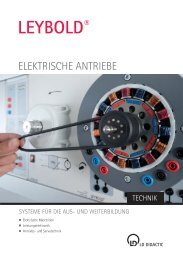
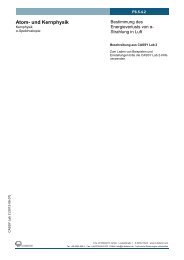
![[667 359] Labor-Refraktometer - LD DIDACTIC](https://img.yumpu.com/24788329/1/184x260/667-359-labor-refraktometer-ld-didactic.jpg?quality=85)
